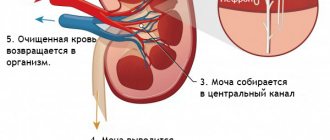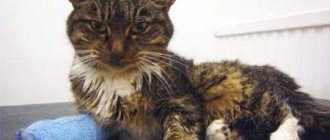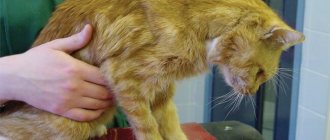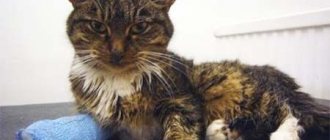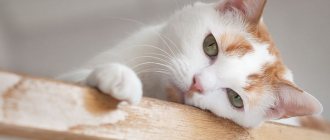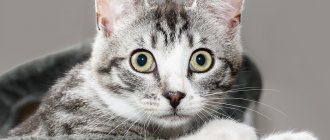Kidney failure in cats is such a serious disease that delay in diagnosis and treatment can be fatal. To save the animal and extend its life for several years, it is necessary to contact the veterinary clinic as soon as the first manifestations of this disease are noticed.
Why does kidney failure occur?
Under the influence of various pathologies, kidney tissue is destroyed or degenerated, becoming covered with connective tissue. Because of this, the organ stops working normally. Violation of excretory function affects water-salt balance, digestion, metabolism and other important processes. All internal organs are affected.
The cause of the pathological condition is other diseases affecting the functioning of the genitourinary system. This is why it is so important to treat any disease at an early stage, preventing it from becoming chronic.
Unfavorable factors
Kidney failure in cats does not appear on its own, but is always a consequence. Unfavorable factors that provoke its development include:
- mechanical kidney injuries;
- pyelonephritis caused by bacteria;
- cysts in the kidneys (polycystic disease);
- underdevelopment of one of the kidneys (unilateral hypoplasia), fraught with its failure in old age, or its shrinkage (nephrosclerosis);
- degenerative change in the renal tubules (nephrosis) or damage to the zona glomerulosa (glomerulonephritis);
- diabetes mellitus affecting the blood vessels of the kidneys (diabetic nephropathy);
- pneumonia (pneumonia);
- benign and malignant neoplasms;
- infections (leptospirosis, parvovirus enteritis, piroplasmosis, calcivirosis);
- inflammation of blood vessels (vasculitis);
- urolithiasis (UCD).
In addition to the listed diseases, structural changes are caused by congenital pathologies, frequent inflammation and neglect of treatment recommendations. Intoxication with poisons or drugs may also be the cause.
At-risk groups
The risk group includes breeds with a genetic predisposition. These include Abyssinians, Persians and animals obtained by crossbreeding with the Persian cat.
Representatives of the Abyssinian breed suffer from amyloid dystrophy, that is, a disorder of protein metabolism. Amyloid, an abnormal protein, is deposited in the tissues of a sick cat, causing organ death by displacing all vital elements.
Persians and their mestizos suffer from various forms of polycystic disease. The first - from the autosomal recessive form, which manifests itself in early childhood, the second - from the autosomal dominant form, which manifests itself in old age.
The risk group can include animals that have suffered severe infectious diseases: calcivirosis, distemper and others. This also includes animals with latent immunodeficiency virus or coronavirus.
Factors that aggravate the condition of the kidneys include severe poisoning or cancer.
Preventive actions
It is best to prevent the development of chronic renal failure than to then undergo complex and not always effective treatment for this disease. By following the recommendations below, the cat owner will be able to minimize the risk of disease:
- safety precautions must be observed. The cat must be protected from injury, poisoning and self-medication of various diseases must be avoided;
- when diagnosing urolithiasis, the animal must be treated exclusively in the clinic;
- infectious diseases of the urinary system should be diagnosed and treated in a timely manner;
- It is necessary to ensure that your pet does not gain excess weight.
You must also strictly adhere to the doctor’s recommendations if the animal is diabetic, since diabetes can cause the development of chronic renal failure.
Symptoms of disorders
Characteristic signs appear only when more than 70% of tissues are affected. Most often, the disease is diagnosed in animals older than 8 years. Because of this, the first non-obvious symptoms (loss of activity and appetite) are attributed to old age. As the patient’s condition worsens, the symptoms are supplemented by:
- the appearance of an ammonia odor from the mouth and drooling;
- blanching of mucous membranes;
- increased thirst and increased frequency of urination up to 10 times a day (the norm for healthy pets is no more than 3 times);
- periodic temperature fluctuations up or down from normal;
- swelling of the paws, chest and abdomen.
Lack of appetite leads to sudden weight loss. The cat's fur becomes dull and his belly sinks. The ribs become visible to the naked eye. Due to frequent trips to the toilet, the hair on the perineum does not have time to dry. The pet constantly licks itself to get rid of droplets of urine.
With more serious violations, new signs appear:
- unsuccessful visit to the tray;
- alternating diarrhea and constipation interspersed with blood in the stool;
- frequent bloody vomiting;
- severe dehydration, expressed in dry mucous membranes;
- increased blood pressure, which threatens blindness due to rupture of blood vessels in the eyeballs;
- isolated muscle twitching and epileptic seizures.
If you notice any of these symptoms, contact your veterinarian immediately. The later the diagnosis is made, the less chance of a favorable prognosis. If the organ fails completely, the animal falls into a coma and dies.
Causes
Kidney failure may be caused by dehydration
The reasons for the development of PN can be conditionally divided into two groups:
- arising as a result of pathogenic processes directly in the kidneys (effects of toxic substances and medications on the renal pelvis, some infections, nephritis);
- predisposing, when a stress factor, without directly affecting the kidneys, still leads to their damage (destruction of red blood cells).
Similarities and differences between acute renal failure and chronic renal failure
According to the nature of the disease, it can be acute (ACN) or chronic (CRF). The latter type takes longer to develop, but is also more difficult to diagnose due to the long absence of symptoms.
Manifestation of acute renal failure
Symptoms of acute renal failure develop suddenly and rapidly. All the main signs appear in a short time. When a cat falls into a coma, the cat’s body becomes cold, but continues to live for another 2-3 days. Deep sleep is distinguished from death by the preservation of weak breathing and the absence of rigor mortis.
Depending on the cause that caused the death of nephrons, there are 3 stages of acute renal failure:
- Prerenal
. Problems with the organ arise due to a reduction in the blood circulating through it. Any shock conditions are to blame for a sharp drop in blood pressure: heat strokes, severe injuries, heavy blood loss, severe dehydration, intoxication.
- Renal
. Associated with direct damage to kidney tissue. It is caused by the deposition of heavy metal salts, intoxication with drugs and poisons, increased blood clotting, viral and bacterial infections.
- Postrenal
. The development of the disease begins with mechanical blockage or compression of the organs performing the urinary function. This occurs with urolithiasis, internal pelvic injuries and the development of neoplasms.
The diagnosed stage affects the further prognosis. A favorable outcome is possible only in the first and last cases.
Manifestation of chronic renal failure
The growth of connective tissue is accompanied by scarring, shrinking the organ to a size that loses functionality. CRF is most often diagnosed in older cats. The severity of symptoms depends on the stage of the disease:
- Latent
. No external changes. Any irregularities that appear can only be detected by testing.
- Initial
. Lasts a couple of months. The symptoms are vague, so they are often correlated with other pathological processes. An accurate diagnosis is made by a blood test. Most indicators deviate from normal.
- Conservative
. Characteristic signs appear that are noticeable to the owner. Most often at this stage the animal is referred for diagnostics. A blood test reveals a strong deviation in creatinine and nitrogen.
- Terminal
. The pathological process affects other organs, causing their dysfunction. Without timely surgery or blood purification (hemodialysis), the sick pet dies.
Due to the fact that clear signs appear late, the disease is practically not diagnosed before the third stage. The causes of chronic renal failure are tumors, urolithiasis, polycystic disease, congenital pathologies, chronic pancreatitis, metabolic disorders and chronic diseases of viral or bacterial etiology.
Pathology can also develop against the background of acute renal failure. In this case, all symptoms subside sharply, and the patient’s condition temporarily improves.
In addition to the duration of development and blurred symptoms, chronic renal failure differs from acute renal failure in the presence of anemia and the absence of pain on palpation. Both pathological forms share only possible symptoms and an unfavorable prognosis if detected late.
Stabilization of the patient's condition
The patient's recovery may take from several days to several months. The improvement is characterized by a decrease in blood creatinine/urea levels and normalization of the acid-base balance. Hospitalization of the patient is indicated until there is a persistent decrease/normalization of renal parameters within 3-5 days.
The prognosis depends on how quickly treatment was started, how quickly diuresis was restored, and what concomitant pathologies are observed in your pet.
(c) Veterinary center for the treatment and rehabilitation of animals “Zoostatus”. Varshavskoe highway, 125 building 1. tel. 8 (499) 372-27-37
Diagnostics in a veterinary clinic
To confirm the disease and determine its form, the veterinarian examines the patient with a mustache, collects anamnesis and conducts diagnostic tests. The mandatory list includes:
- Analysis of urine
. The diagnosis is confirmed by elevated levels of protein and blood cells. The color of the discharge changes to black or almost transparent. The density of urine decreases and sediment appears. The pH level shifts towards an acidic environment.
- Blood analysis
. The amount of glucose, leukocytes, creatinine and phosphates deviates upward. Lymphocytes, hematocrit, platelets and hemoglobin fall. In chronic renal failure, severe anemia is diagnosed.
- Ultrasound
. The examination shows changes in contour and size, as well as the formation of cysts or other neoplasms.
- X-ray
. Determines the area and extent of damage.
A cat with acute renal failure tolerates palpation painfully. Her kidneys are enlarged and her bladder is full of urine. When the urinary organs rupture, free fluid may enter the peritoneum or subcutaneous tissue.
CRF is confirmed by a noticeable softening of the facial bones, which are left without the required amount of calcium. Ulcers may appear on the tongue.
Diagnostic tests
An accurate diagnosis can only be made in a hospital setting, using laboratory and instrumental methods:
- Biochemistry of blood. The analysis determines the level of urea, potassium, creatinine, sodium, calcium, chlorine, magnesium, cfc.
- Ultrasound examination of the organ. It will show its shape, structure, location, and the presence of cysts. Kidney ultrasound is one of the most informative methods for diagnosing the disease.
- X-ray using contrast agent. Used to evaluate affected areas of the kidneys.
- General urine analysis. Shows the presence of bacteria and renal epithelium in urine, determines the level of leukocytes.
Computed tomography of the kidneys is considered the most accurate diagnostic method, but due to the high cost of analysis, this method is practically not used.
How are acute renal failure and chronic renal failure treated?
Kidney failure in cats is incurable. Unlike hepatocytes (liver cells), nephrons do not regenerate. Treatment is aimed at increasing possible life expectancy and maintaining its quality.
A sick pet will have to undergo regular tests and take medications to prevent its kidneys from failing. More detailed therapy will depend on the course of the pathology:
- Acute
. After identifying and eliminating the root cause, rehydration is carried out to eliminate the effects of dehydration. With the help of medications, the patient eliminates hemolysis (destruction of red blood cells) and relieves the consequences of poisoning. In especially severe cases, hemodialysis is prescribed. After inpatient treatment, the animal is sent home and put on a recovery diet.
- Chronic
. Without starting from the cause, doctors try to stimulate appetite with the help of a maintenance diet. Blood pressure and all metabolic processes are normalized. The consequences of anemia are eliminated with hematopoietic drugs (Ursoferran, Recormon, Hemobalance). More vitamins are added to the diet. Hemodialysis is mandatory.
Without finding out the root cause, it is impossible to stop the pathological process. Remission after symptomatic treatment will certainly end in relapse. Ultimately, the pathology will become chronic.
List of medications
It is impossible to say how long a pet will live before starting treatment. Life expectancy depends on the body's response to the medications used. The veterinarian may prescribe:
- glucocorticosteroids (Dexamethasone, Prednisolone, Methylprednisolone), suppressing immune reactions and relieving swelling;
- diuretics (Furosemide), laxatives (Lactusan, Duphalac) and antiemetics (Famotidine, Metoclopramide) drugs;
- potassium-containing drugs (Panangin), which replenish potassium levels;
- rehydration and nutritional solutions (Ringer's solution, glucose, Trisol, saline solution), eliminating the effects of dehydration and normalizing metabolic processes;
- drugs to lower blood pressure (Ramipril, Enalapril);
- detoxification (Liarsin, Sirepar, Enterosgel) and hemostatic (Vikasol, Ditsinon) drugs;
- antibiotics (Baytril, Enrofloxacin, Sinulox) that eliminate primary factors;
- cardiogenic drugs (Riboxin, Cocarboxylase, Sulfocamphocaine) that prevent ruptures in capillaries.
To restore appetite, the animal is forcibly administered nutrient mixtures hourly. Intestinal microflora is normalized with medications containing beneficial bacteria.
Self-selection of medications is unacceptable. The treatment regimen is developed based on the patient's diagnosis. The veterinarian can replace the listed drugs with others, expand or reduce the list.
Lifelong diet and care
Regardless of the form of the disease, treatment involves following a diet. You will have to stick to the new menu for at least six months. Returning familiar products immediately after eliminating symptoms is unacceptable, since the doctor makes this decision only on the basis of changes in the tests. If kidney damage is over 75%, the therapeutic diet is followed for life.
Dairy products, fatty meat and fish, salt, fish oil and caviar are prohibited. The abundance of phosphorus complicates the course of the disease, negatively affecting the condition of the bones and central nervous system. Its daily rate is reduced to 65-85 g per 1 kg of animal weight.
It is allowed to eat lean meats (chicken, rabbit, turkey), cabbage and carrots. Twice a week the cat is given boiled chicken hearts and liver. Meat is served boiled or raw. In the latter case, it is well frozen in the freezer to destroy all parasites. Offal is served strictly boiled after deep freezing. There should be no more than 4.5 g of protein per 1 kg of cat weight.
At high urea values (30 mmol/l), energy must be obtained from unsaturated fats and carbohydrates. Proteins are temporarily excluded. The patient is fed oat pancakes, pasta with vegetable oil and bread. A small amount of sugar is added to dishes.
Provide constant access to fresh water and feed your pet in small portions. Don't go hungry. When refusing food, hand feed the patient, administer liquid food through a syringe, or heat food before serving to enhance its flavor.
When dry feeding, it is recommended to choose medicated food labeled Renal. This product contains reduced protein and phosphorus and is available in the form of granules and mousse.
Avoid independent walks outside to protect your pet from injury and infection. Do not touch his stomach, as any touch will cause severe pain and aggravate the condition. Place the sick cat in a quiet and warm place, protected from outside noise and drafts.
Self-installation of an IV
To reduce the load on the kidneys, veterinarians prescribe subcutaneous infusions of saline. Sometimes saline solution is mixed with other drugs. The dosage, duration of the course and its repeated use are prescribed only by a veterinarian.
Sometimes infusions need to be done for a long time - up to a month continuously, if the condition of the kidneys is poor. Taking your cat to the veterinarian every day is not only expensive, but also dangerous for the animal’s health, since excess stress aggravates the situation.
Some owners call a veterinary nurse to their home, while others decide to carry out the procedure themselves. In fact, subcutaneous infusions are not that complicated, and mastering them is easier than it seems.
The dropper is placed at the withers, since this is where cats have the least nerve endings and the most space for fluid. The volume of a single infusion can range from 50 to 100 milliliters at a time. The vast majority of people with mustaches tolerate the procedure calmly.
It is most convenient to use the so-called “butterfly”: it is a short needle with a large cavity, it speeds up the administration of the drug. Protective “wings” do not allow the tip to slip out, even if the cat begins to struggle during the procedure. For large cats, a thicker needle is recommended, No. 18-19, for medium-sized cats – No. 20-21, for kittens – a needle No. 23.
The needle is equipped with a long “wire”, at the end of which a syringe is inserted. With such a device, making even large subcutaneous infusions is convenient and simple. The most that your pet may not like is that the saline solution tingles slightly, but it is not a painful sensation.
Have one person hold the cat while the other puts in an IV. Another option is to get a retainer bag. You need to strongly pull the skin on the upper part of the neck and insert the needle perpendicular to the spine. Inject the solution neither too quickly nor too slowly, then carefully remove the needle. The cat should not experience any blood or severe pain.
Caring for a sick animal
When diagnosed with chronic renal failure, the main goal of therapeutic measures is to maintain the stable functioning of the remaining healthy cells of the kidney tissue. To reduce the load on these organs, it is necessary to periodically place drips and take medications, the treatment regimen for which is prescribed by the doctor observing the animal. If the condition has been stabilized, examinations are subsequently carried out every 3 months.
It is necessary to constantly monitor the animal’s weight and blood pressure. Sharp jumps in these indicators are an alarming signal.
The owner should know that the further course of the disease, in addition to therapeutic measures, is largely determined by the conditions of keeping and caring for the animal, the most important of which is dietary nutrition. The proper course of metabolic processes, the level of toxins and the body’s ability to get rid of them depend on the quality composition of the diet. The veterinarian recommends a specific diet based on the stage of the disease, the severity of the condition and the individual characteristics of the cat.
In case of aggravated illness, examination and tests are carried out as prescribed by the doctor.
In general, the composition of the feed should be different:
- low phosphorus content;
- optimal amount of protein;
- the presence of alkalizing substances to maintain pH balance.
If a cat is diagnosed with PN, a diet consisting of dry food is contraindicated. In order not to subject the animal to protein starvation and weight loss, experts recommend choosing a special therapeutic and dietary ready-made super-premium food.
At any stage of PN, the general principles of feeding a cat are also relevant:
- to improve kidney function, the medicinal feed should include additional moisture;
- To maintain blood pressure within normal limits, food is recommended whose dry matter sodium content does not exceed 0.5%;
- When eating natural food for cats with PN, the diet must include foods high in Omega-3 fatty acids and antioxidants.
Another problem may be that the animal refuses to eat. In this case, medications are prescribed that stimulate appetite and regulate digestion. Some owners cope with their pets' anorexia by making the food more palatable. For example, you can grind tuna meat to a paste-like consistency, dilute it with low-fat broth, and add this substance to food.
What's the prognosis?
A favorable prognosis is given to animals with prerenal and postrenal stages of acute renal failure. Those who were diagnosed before stage 3 chronic renal failure also have a good chance. With more serious tissue destruction, but with high-quality nutrition and care, cats with a chronic diagnosis live 2-3 years.
In addition to the form and stage of the disease, an important role is played by:
- presence of concomitant diseases;
- patient's age;
- compliance with medical recommendations.
Older pets are more difficult to tolerate pathology, so in their case, doctors are in no hurry to make a prognosis. An unfavorable outcome is also observed in animals at risk who suffer from amyloid dystrophy or polycystic disease. With this diagnosis, over 90% of tissues are destroyed. This condition turns out to be incompatible with life.
Forecast
The outcome of the disease depends on what form of PN was diagnosed, how timely it was done, and whether therapeutic measures were taken that were adequate for the animal’s condition.
When acute renal failure is diagnosed, careful adherence to the treatment regimen and provision of appropriate home care after hospital stay make the prognosis, as a rule, favorable.
CRF is characterized by a sluggish or asymptomatic course. Therefore, veterinary help is most often sought when the disease enters its final stage and the cat can no longer be saved. Attentive pet owners will always promptly notice deviations from their pets’ usual behavior and external changes, which are a signal of the need for a veterinary examination. At the stage of early contact with a specialist and identification of chronic renal failure, the cat has a good chance of stopping the pathological process. Despite the fact that the disease cannot be completely cured, careful care, strict adherence to the schedule of mandatory monitoring of kidney function, and elimination of factors that cause exacerbation of the disease can not only prolong the animal’s life, but also maintain its satisfactory quality.
Elderly cats over 8 years of age and representatives of the Persian, Abyssinian, and Maine Coon breeds are most likely to develop PN.
This disease has stages and substages
IRIS classification of kidney diseases:
Stage 1 (non-azotemic chronic renal failure):
Normal creatinine (less than 140 µmol/L), but there are other abnormalities suggestive of renal failure (eg, renomegaly, proteinuria, poor urinary concentrating ability.)
Stage 2 (weak chronic renal failure):
Creatinine is above 140-250 µmol/l. This lower level of about 140 mmol/L may be within the normalized range.
Stage 3 (moderate chronic renal failure):
Plasma creatinine 251-439 µmol/l.
Stage 4 (severe chronic renal failure):
Cats in this stage of CRF have creatinine levels greater than 440 µmol/L.
Substages of chronic renal failure:
- Non-proteinuric less than 0.2 protein
- Borderline proteinuric 0.2–0.4
- Proteinuric acid more than 0.4
